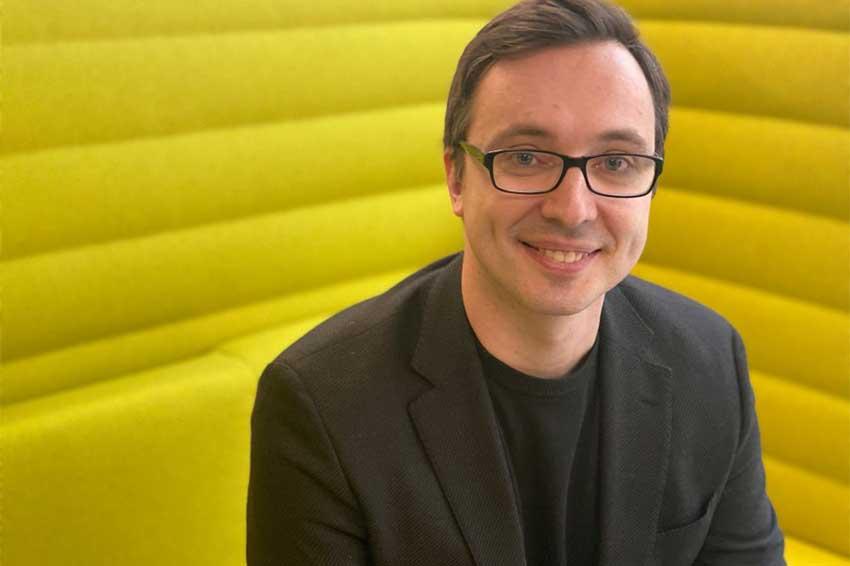New W3-professorship for ultrafast microscopy and photonics
Ultrafast & ultrathin: Alexey Chernikov’s research makes mysterious quantum world visible
The quantum materials that Chernikov and his team study are as thin as just a few atoms. The main focus is the study of elusive quasiparticles. A quasiparticle consists of several electrons that behave jointly as a new, independent entity. They can play a decisive role for the absorption and emission of light as well as for the conduction of electricity. In nanostructures – such as the super-thin crystals – quasiparticles are particularly robust, interact strongly with each other, and can be precisely manipulated by electric and magnetic fields as well as by the environment. Chernikov focuses on studying and understanding their composition, interactions, and their motion. To do so, quasiparticles are recorded in ‘real time’ using a specialized technique to essentially make movies of their movement.
The study of quasiparticles is currently being intensely pursued in the field of modern solid-state physics. “Alexey Chernikov opens up an important new research area in the Cluster of Excellence ct.qmat,” emphasizes Prof Matthias Vojta, spokesperson of the Dresden branch of the cluster. In the future, materials such as the ultrathin films studied by Chernikov might serve as a basis for novel laser sources, light sensors, solar cells or even as building blocks for quantum computers.
Light as a tool
To monitor the behavior of quasiparticles in atomically thin crystals and in more complex, composite structures, the newly appointed Prof Chernikov and his team use light as a tool. "First, we activate the material with ultrashort pulses of light from a powerful laser source and then use superfast detectors to record when, where, and how the light is re-emitted by the crystal. In this manner we gain insight into the composition of the quasiparticles, learn their motion patterns, and can draw conclusions regarding resulting material properties" explains Chernikov, who was awarded the Heinz Maier-Leibnitz Prize of the German Research Foundation (DFG) in 2018 for his work in the field of two-dimensional semiconductors.
“We take an accurate, close look at how the stored energy and information is transported and what promotes or inhibits the quasiparticle movement,” the scientist explains. “There are also clear differences whether the particles travel alone or in groups and how they react to their immediate environment. Sometimes it’s almost like with us, people. All in all, this research is very exciting for me – first and foremost to understand fundamental many-particle physics in condensed matter. At the same time, future information technologies will require new materials and processes that make the devices compact, fast and flexible. In that respect, ultrathin crystals offer a lot of potential.”
‘Slow motion’ for ultrafast quasiparticles
The smallest of particles in condensed matter – such as individual electrons or their quasiparticle complexes – move rapidly through a crystal, on time scales of only a few picoseconds. Chernikov and his team use optical methods to record these ultrafast processes in such a way that the quasiparticle movements become visible. Moreover, as these particles interact strongly with each other in nanostructures, novel collective phenomena emerge –formation of luminous micrometer-sized rings, for example, or an unusual behavior of particle currents that defies classical explanations. “Even though such effects are currently observed mainly at extremely low temperatures, we are jointly striving in the Cluster of Excellence ct.qmat to make these exotic phenomena applicable under atmospheric, room-temperature conditions– to serve as a basis for revolutionary quantum chips and future technical applications,” adds the cluster’s spokesperson Prof Vojta.
“I am very much looking forward to work within ct.qmat. As a research location, Dresden offers a truly exceptional, exciting environment with its close connection to the four large partner institutes as well as to Würzburg,” says Chernikov, who previously led an Emmy Noether junior research group at the University of Regensburg from 2016 to 2021 and has moved to Dresden in August 2021. Last year, he was also awarded an ERC Consolidator Grant from the European Research Council (ERC) with about two million euros of funding to explore and develop novel concepts to control quantum states in nanostructures. His studies of optical excitations in atomically thin films began at Columbia University (New York, USA), where he conducted research supported by the Feodor-Lynen grant of the Alexander von Humboldt Foundation from 2013 to 2016. The physicist’s doctoral thesis was awarded summa cum laude by Philipps University of Marburg, Germany. Chernikov was born in St. Petersburg, Russia, and came to Germany at the age of 14 as a child of Russian-Jewish emigrants. He is married and has two small children.
Currently, Chernikov’s group is setting up new laboratories at the Institute of Applied Physics at TU Dresden. A variety of novel research approaches and experimental schemes is being developed to investigate the behavior of quasiparticles under the influence of high electric and magnetic fields, create artificial, hybrid heterostructures, and explore advanced strategies to control light emitters on the nanoscale. The team invites graduate students and experienced postdoctoral researchers for joint projects. In the course of the year, the 38-year-old scientist plans to supervise bachelor’s and master’s theses as well as to offer teaching courses.







